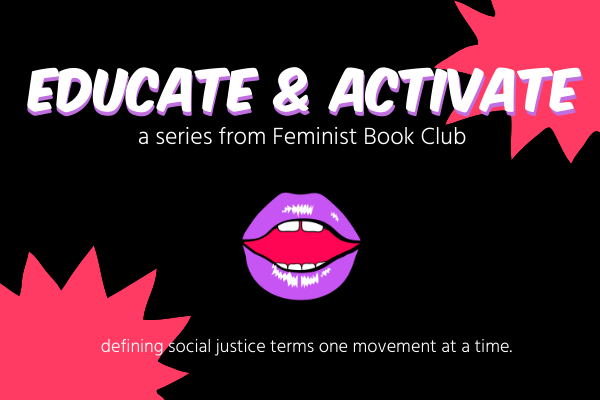Introduction:
Feminist Book Club blog contributors are working together to create posts as an “Educate & Activate” series. We will define a term or movement, provide historical context, and give you additional resources to learn more. We believe that an educated populace can be better activists, accomplices and co-conspirators. It is important to note that these are meant to be brief descriptions and not inclusive or exhaustive of all resources. We urge you to continue being curious, and continue learning more.
Definition
What is immigration? Immigration is the action of coming to live permanently in a country. It is different from emigration which “means to leave one location, such as one’s native country or region, to live in another,” focusing on the exit of a country. Immigration focuses on entry or being inside a country.
First usage
Noah Webster, author of An American Dictionary of the English Language (1828), invented the word “immigration.” He took all variations of to migrate, “including commigrate, transmigrate, emigrate, and remigrate” and transformed them, based “on his long study of word origins and perhaps his own historical experience as an ardent American nationalist.”
Historical context
The term immigrant was used in 1792 as someone who immigrates and was “based on French immigrant, from Latin immigrantem…, present participle of immigrare “to remove, go into, move in.”
Apart from immigration and emigration, the other terms that are confusing are “expat” and “migrant.” Migrants are “people who intend to go and live in a county for a long time and they’re not allowed to. They have to go home when they’ve completed their assignment.” They are also referred to as nonimmigrants. On the other hand, expats (shortened form expatriate) are people who “move abroad for a limited amount of time or have not yet decided upon the length of their stay.” The added politics of using terminology is that immigrants can be expats but “expat is a term reserved exclusively for western white people going to work abroad.” This double standard is woven into official policies, too.
Ellis Island opened as an immigration station in 1892, serving for more than sixty years till its closure in 1954. By estimation, close to 40% of all current American citizens trace one of their ancestors to Ellis Island. More immigrants from southern and eastern Europe, including Jews escaping from oppression, were arriving at Ellis Island, than people from “Germany, Ireland, Britain and the Scandinavian countries.” Others included “Poles, Hungarians, Czechs, Serbs, Slovaks and Greeks, along with non-Europeans from Syria, Turkey, and Armenia.”
The first federal immigration law, the Naturalization Act, was passed in 1790 which allowed “all white males living in the U.S. for two years to become citizens.” President Warren G. Harding’s Emergency Quota Act was signed into law in 1921, “annual immigration from any country cannot exceed 3 percent of the total number of U.S. immigrants from that same country, as recorded in the U.S. Census of 1910.”
The Immigration Act of 1924 set “strict quotas for immigrants based on country of origin, including an annual limit of 165,000 immigrants from outside the Western Hemisphere.” The quota system was abolished by President Johnson’s Immigration and Naturalization Act of 1965 and established the foundations of modern American immigration law.
As per the latest Pew Research Center findings, “Immigrants today account for 13.7% of the U.S. population” and “Most immigrants (77%) are in the country legally.” Even though Mexico is the top origin country of US immigration, the next largest origin groups are from “China (6%), India (6%), the Philippines (4%) and El Salvador (3%).”
Immigration is an important and real aspect of the US and despite changes in policies and laws, there will hopefully not be any halt to immigration to the US. This is borne by the Pee finding, that “About two-thirds of Americans (66%) say immigrants strengthen the country ‘because of their hard work and talents,’ while about a quarter (24%) say immigrants burden the country by taking jobs, housing, and health care.”
Resources for Further Education (this is by no means an exhaustive list):
The Book of Unknown Americans by Cristina Henríquez
How the García Girls Lost Their Accents by Julia Alvarez
Breath, Eyes, Memory by Edwidge Danticat
Unaccustomed Earth by Jhumpa Lahiri
Behold the Dreamers by Imbolo Mbue
The Ungrateful Refugee: What Immigrants Never Tell You by Dina Nayeri
The Undocumented Americans by Karla Cornejo Villavicencio
Good Talk: A Memoir in Conversations by Mira Jacob
The Best We Could Do: An Illustrated Memoir by Thi Bui
Tell Me How it Ends: An Essay in Forty Questions by Valeria Luiselli
American Immigration: A Very Short Introduction by David A. Gerber
Key terms on the International Organization for Immigration
Video on the history of immigration in the US
Video on US immigration policies
Immigrantly podcast that features immigrants from all walks and experiences of life
Immigration Nation podcast on tackling myths and misconceptions about immigrants and educating about the US immigration policy
Only in America podcast on how to progress with immigration
This Week in Immigration podcast gives a brief rundown of key immigration issues


